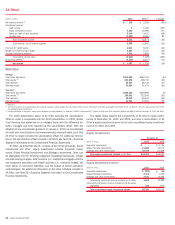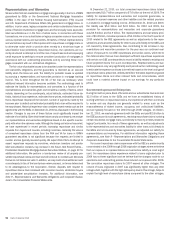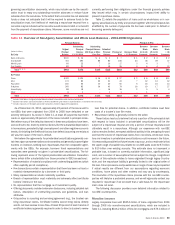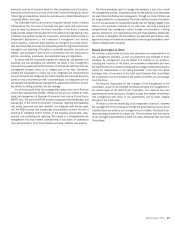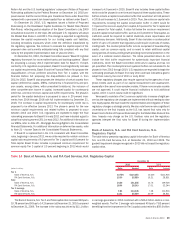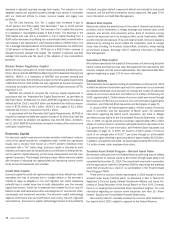Bank of America 2010 Annual Report Download - page 63
Download and view the complete annual report
Please find page 63 of the 2010 Bank of America annual report below. You can navigate through the pages in the report by either clicking on the pages listed below, or by using the keyword search tool below to find specific information within the annual report.requirements over banks; includes new minimum leverage and risk-based
capital requirements for large financial institutions; disqualifies trust pre-
ferred securities and other hybrid capital securities from Tier 1 capital; and
requires securitizers to retain a portion of the risk that would otherwise be
transferred into certain securitization transactions. Many of these provisions
have begun to be phased-in or will be phased-in over the next several months
or years and will be subject both to further rulemaking and the discretion of
applicable regulatory bodies.
The Financial Reform Act will continue to have a significant and negative
impact on our earnings through fee reductions, higher costs and new restrictions,
as well as reduce available capital. The Financial Reform Act may also continue to
have a material adverse impact on the value of certain assets and liabilities held
on our balance sheet. The ultimate impact of the Financial Reform Act on our
businesses and results of operations will depend on regulatory interpretation and
rulemaking, as well as the success of any of our actions to mitigate the negative
earnings impact of certain provisions. For information on the impact of the
Financial Reform Act on our credit ratings, see Liquidity Risk beginning on page 71.
The Financial Reform Act and other proposed regulatory initiatives may
also have an adverse impact on capital. During 2010, the Basel Committee on
Banking Supervision finalized rules on certain capital and liquidity measure-
ments. For additional information on these rules, see Regulatory Capital –
Regulatory Capital Changes beginning on page 68.
Debit Interchange Fees
The limits that the Financial Reform Act places on debit interchange fees will
significantly reduce our debit card interchange revenues. Interchange fees, or
“swipe” fees, are charges that merchants pay to us and other credit card
companies and card-issuing banks for processing electronic payment trans-
actions. The legislation, which provides the Federal Reserve with authority
over interchange fees received or charged by a card issuer, requires that fees
must be “reasonable and proportional” to the costs of processing such
transactions. The Federal Reserve considered the functional similarity be-
tween debit card transactions and traditional checking transactions and the
incremental costs incurred by a card issuer in processing a particular debit
card transaction. In addition, the legislation prohibits card issuers and net-
works from entering into exclusive arrangements requiring that debit card
transactions be processed on a single network or only two affiliated networks,
and allows merchants to determine transaction routing.
On December 16, 2010, the Federal Reserve issued a proposed rule that
would establish debit card interchange fee standards and prohibit network
exclusivity arrangements and routing restrictions. The Federal Reserve re-
quested comments on two alternative interchange fee standards that would
apply to all covered issuers: one based on each issuer’s costs, with a safe
harbor initially set at $0.07 per transaction and a cap initially set at $0.12 per
transaction; and the other a stand-alone cap initially set at $0.12 per trans-
action. The Federal Reserve also requested comment on possible frameworks
for an adjustment to the interchange fees to reflect certain issuer costs
associated with fraud prevention. If the Federal Reserve adopts either of
these proposed standards in the final rule, the maximum allowable inter-
change fee received by covered issuers for debit card transactions would be
more than 70 percent lower than the 2009 average once the new rule takes
effect on July 21, 2011. The proposed rule would also prohibit issuers and
networks from restricting the number of networks over which debit card
transactions may be processed. The Federal Reserve requested comment
on two alternative approaches: one alternative would require at least two
unaffiliated networks per debit card, and the other would require at least two
unaffiliated networks per debit card for each type of cardholder authorization
method (such as signature or PIN). Under both alternatives, the issuers and
networks would be prohibited from inhibiting a merchant’s ability to direct the
routing of debit card transactions over any network that the issuer enabled to
process them.
As previously announced on July 16, 2010, as a result of the Financial
Reform Act and its related rules and subject to final rulemaking over the next
year, we believe that our debit card revenue will be adversely impacted beginning
in the third quarter of 2011. Our consumer and small business card products,
including the debit card business, are part of an integrated platform within the
Global Card Services business segment. In 2010, our estimate of revenue loss
due to the debit card interchange fee standards to be adopted under the
Financial Reform Act was approximately $2.0 billion annually based on 2010
volumes. As a result, we recorded a non-tax deductible goodwill impairment
charge for Global Card Services of $10.4 billion in 2010. We have identified
other potential mitigation actions within Global Card Services, but they are in the
early stages of development and some of them may impact other segments. The
impairment charge, which is a non-cash item, had no impact on our reported
Tier 1 and tangible equity ratios. If the Federal Reserve sets the final interchange
fee standards at the lowest proposed fee alternative, as described above (i.e.,
$0.07 per transaction) the lower interchange revenue may result in additional
impairment of goodwill in Global Card Services. In view of the uncertainty with
model inputs including the final ruling, changes in the economic outlook and the
corresponding impact to revenues and asset quality, and the impacts of mit-
igation actions, it is not possible to estimate the amount or range of amounts of
additional goodwill impairment, if any, associated with changes to interchange
fee standards. For more information on goodwill and the impairment charge,
refer to Note 10 – Goodwill and Intangible Assets to the Consolidated Financial
Statements and Complex Accounting Estimates beginning on page 111.
Limitations on Certain Activities
We anticipate that the final regulations associated with the Financial Reform
Act will include limitations on certain activities, including limitations on the use
of a bank’s own capital for proprietary trading and sponsorship or investment
in hedge funds and private equity funds (Volcker Rule). Regulations imple-
menting the Volcker Rule are required to be in place by October 21, 2011, and
the Volcker Rule becomes effective twelve months after such rules are final or
on July 21, 2012, whichever is earlier. The Volcker Rule then gives banking
entities two years from the effective date (with opportunities for additional
extensions) to bring activities and investments into conformance. In antici-
pation of the adoption of the final regulations, we have begun winding down
our proprietary trading line of business. The ultimate impact of the Volcker
Rule or the winding down of this business, and the time it will take to comply or
complete, continues to remain uncertain. The final regulations issued may
impose additional operational and compliance costs on us.
Derivatives
The Financial Reform Act includes measures to broaden the scope of deriv-
ative instruments subject to regulation by requiring clearing and exchange
trading of certain derivatives, imposing new capital and margin requirements
for certain market participants and imposing position limits on certain
over-the-counter (OTC) derivatives. The Financial Reform Act grants the
U.S. Commodity Futures Trading Commission (CFTC) and the SEC substantial
new authority and requires numerous rulemakings by these agencies. Gen-
erally, the CFTC and SEC have until July 16, 2011 to promulgate the rule-
makings necessary to implement these regulations. The ultimate impact of
these derivatives regulations, and the time it will take to comply, continues to
remain uncertain. The final regulations will impose additional operational and
compliance costs on us and may require us to restructure certain businesses
and negatively impact our revenues and results of operations.
Bank of America 2010 61





